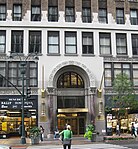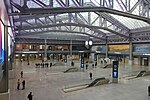Pennsylvania Station (1910–1963)

Pennsylvania Station, often abbreviated to Penn Station, was a historic railroad station in New York City, named for the Pennsylvania Railroad (PRR), its builder and original tenant. The station occupied an 8-acre (3.2 ha) plot bounded by Seventh and Eighth Avenues and 31st and 33rd Streets in Midtown Manhattan. As the station shared its name with several stations in other cities, it was sometimes called New York Pennsylvania Station. The building was designed by McKim, Mead, and White and completed in 1910, enabling direct rail access to New York City from the south for the first time. Its head house and train shed were considered a masterpiece of the Beaux-Arts style and one of the great architectural works of New York City. The station contained 11 platforms serving 21 tracks, in approximately the same layout as the current Penn Station. The original building was one of the first stations to include separate waiting rooms for arriving and departing passengers, and when built, these were among the city's largest public spaces. Passenger traffic began to decline after World War II, and in the 1950s, the Pennsylvania Railroad sold the air rights to the property and shrank the railroad station. Starting in 1963, the above-ground head house and train shed were demolished, a loss that galvanized the modern historic preservation movement in the United States. Over the next six years, the below-ground concourses and waiting areas were heavily renovated, becoming the modern Penn Station, while Madison Square Garden and Pennsylvania Plaza were built above them. The sole remaining portions of the original station are the underground platforms and tracks, as well as scattered artifacts on the mezzanine level above it.
Excerpt from the Wikipedia article Pennsylvania Station (1910–1963) (License: CC BY-SA 3.0, Authors, Images).Pennsylvania Station (1910–1963)
Pennsylvania Plaza, New York Manhattan
Geographical coordinates (GPS) Address Nearby Places Show on map
Geographical coordinates (GPS)
| Latitude | Longitude |
|---|---|
| N 40.7503 ° | E -73.9931 ° |
Address
Pennsylvania Station
Pennsylvania Plaza
10119 New York, Manhattan
New York, United States
Open on Google Maps






